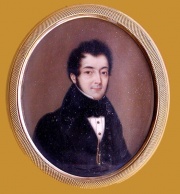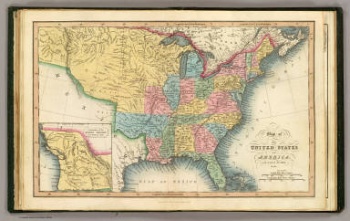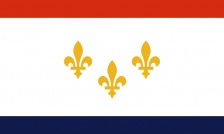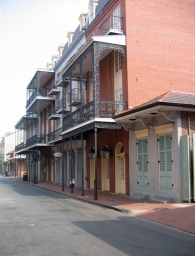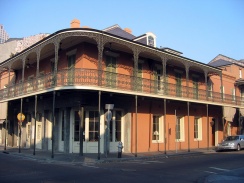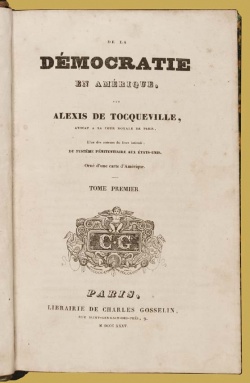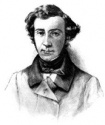Alexis de Tocqueville in Louisiana in 1832
par Corbo, Claude
Alexis de Tocqueville (1805-1859) journeyed to the United States in 1831 and 1832 accompanied by his colleague, French Magistrate Judge Gustave de Beaumont. His official purpose was to study the penal system in place there. Despite his official purpose, his travels enabled him to better understand the phenomenon of democracy in America and its inevitable development. This journey also permitted the two men to establish first hand contact with the aftermath of French colonization in North America for the first time. They came into contact with survivors from the final years of French military and political presence on the continent. Tocqueville and Beaumont had previously spent time in Lower Canada at the end of summer in 1831. Then, from the 1st to the 3rd of January, 1832, they went to New Orleans, Louisiana. The observations made during this last visit stood out in contrast to what they had seen in Lower Canada.
Article disponible en français : Alexis de Tocqueville et la Louisiane en 1832
Louisiana in 1832
Louisiana was, as of the 30th of April 1812, the eighteenth state in the United States. The state was only a small part of the immense territory that the American Republic, on the initiative of President Thomas Jefferson, had bought from the emperor Napoleon Bonaparte in 1803. The territory had been claimed by France, but only minimally occupied. The purchase of this land by the United States assured the Americans control of the North American hinterland from the Mississippi to the foothills of the Rocky Mountains. The United States would eventually be able to accomplish its Manifest Destiny of appropriating land "from sea to shining sea" with the subsequent acquisition of territories west of the Mississippi reaching as far as the Pacific Ocean. At the beginning of the 1830's, New Orleans was the main seaport of the territory and was a very economically active city. According to Toqueville, it was "(...) a forest of seagoing vessels". In 1828, he learned that the port had, up to that date, been able to accommodate "close to 1000 sailing vessels and 770 steamships"(NOTE 1).
Perspectives on Louisiana
According to his notes, Tocqueville had two notable encounters during his time in New Orleans. The first was a meeting with Étienne Mazureau (1777-1849), a wealthy reputed lawyer and once former Attorney General of Louisiana. Mazureau, originally from France, had arrived in the United States in 1803. Toqueville's other encounter was with a French consular officer, a man by the name of Guillemin. Tocqueville's conversations with the two men allowed him to observe the similarities and differences between Lower Canada and Louisiana.
There are striking similarities between the two former French colonies. In both cases, the territories quickly distance themselves from the French political tradition, in order to develop their own distinctive systems. However, they both preserved important elements from their predecessors, including the language and civil code. In addition, Tocqueville mentions something that he had already noticed in Quebec City and Montreal: the predominant use of English for commercial signs. He remarks, "[...it was] a generally French area, however, signs and commercial advertising are generally in English."(NOTE 2) Tocqueville explains the situation in the following way "[It is an] American commercial and industrial world" (something he emphasised himself). According to Guillemin, (Tocqueville cites Guillemin's words) there is also a feeling of attachment to things considered French. This country, according to him, "[...] is essentially French in its ideas, customs, opinions, and ways. It is modelled ostensibly on France."(NOTE 3) As for economic life, he notes that the situation of French speakers in Louisiana is similar to that of their cousins in Lower Canada. On the one hand, the land belongs to the French speaking population, but the upper management [and ownership] levels of business are in the hands of the Americans. Secondly, "the French in Louisiana are not enterprising in business. They don't like to risk their property and are afraid of the dishonour of failure". However, "the Americans (...) are consumed by the desire for riches."(NOTE 4)
These similarities would not overshadow the considerable differences that existed between the two former French colonies. In New Orleans, the population is very diverse, a fact that is evident in numerous ways. According to Tocqueville, the architecture is "Spanish (flat roofs), English (brick construction, small doors), French (large carriage entrances). In addition, the population is mixed, with all shades of colour: speaking French, English, Spanish and Creole."(NOTE 5) The presence of slavery and a large black population drew his attention as he wondered about their living conditions. The question of mixed races intrigued him in this city where customs seemed to be very liberal.(NOTE 6)
Louisiana and Lower Canada also differed in other ways. For example, the control of the Catholic Church was weaker in Louisiana. There is a separation of Church and State imposed by the American constitution. According to Guillemen, "there is no political animosity against the ministers of the Catholic faith who, for their part, stay out of political affairs."(NOTE 7) On the political scene, Mazureau explained that Louisiana had progressively and quickly obtained the power to govern itself as a state. The American Congress, he said, "governed us in the beginning in a way similar to our old governors. Then, they gave us territorial legislation and, finally, added us to the Union as an independent state."(NOTE 8) At the time, in Lower Canada, the elected assembly was in open conflict with the governor over control of the colonial budget. Furthermore, the spirit of equality that characterized American Democracy shaped the way the different groups interacted with each another in New Orleans. All the various members were part of the same republic, and thus the differences between groups were not causes of conflict. Guillemin clearly summarizes yet another major difference between Lower Canada and Louisiana: "The French do not live here like they do in Canada, where they are the conquered people. There lives are founded on real and complete equality. They are endlessly establishing partnerships with the Americans."(NOTE 9)
Two Different Destinies
Tocqueville's time spent in New Orleans was shorter than that spent in Lower Canada, and so, there are fewer written records. The records that do exist are mostly transcriptions of his conversations with Mazureau and Guillemin, in which the differences between the two former French colonies in North America are highlighted. In contrast with his visit to Lower Canada, his time in New Orleans did not lead to any written summary of his observations and his conversations.
Along with the issues mentioned, Tocqueville was also preoccupied with the major constraints on the French speaking communities of North America. Certain remarks by Guillemin touch on a theme that also surfaces in Tocqueville's writings. He talks about the weakness of the French colonizing efforts. According to Toquevilles's remarks, Louisiana well illustrates this fact: "We could have at least (...) made an effort to establish a French population that would have eventually been able to take care of itself. We are now too weak to stand up to the pressure exerted by the American population."(NOTE 10) It is interesting to note that Tocqueville does not make any reference to the French-speaking population in Louisiana that descended from Acadians deported in 1755 (today's "Cajuns").
Tocqueville's thoughts on Louisiana reaffirm what he had noticed in Lower Canada: that the destiny of French speaking people in North America was precarious. As he wrote in his book, De la Démocratie en Amérique, "Today, there are truly only two rival peoples that share the New World: the Spanish and the English."(NOTE 11) Tocqueville reminds us that, in Louisiana, as in Lower Canada, maintaining the presence of the French language in North America is-whether historically or contemporarily speaking-an ongoing challenge.
Claude Corbo
Department of Political Science
Université du Québec à Montréal
NOTES
Note 1. Alexis de Tocqueville, Œuvres, Paris, Gallimard, « Bibliothèque de la Pléiade », 1991, tome I, p. 181.
Note 2. Œuvres, t. I, p. 180.
Note 3. Ibid., p. 119.
Note 4. Ibid. p. 120.
Note 5. Ibid., p. 180.
Note 6. "Les femmes de couleur dévouées en quelque sorte par la loi au concubinage. Relâchement incroyable dans les mœurs" [Coloured women are somehow bound in common-law marriages. An incredible loosening of morals], Œuvres, tome I, p. 180.
Note 7. Ibid., p. 121.
Note 8. Ibid., p. 117.
Note 9. Ibid., p. 120.
Note 10. Ibid.
Note 11. Alexis de Tocqueville, Œuvres, Paris, Gallimard, « Bibliothèque de la Pléiade », 1992, tome II, p. 475.
BIBLIOGRAPHY
1) Works by Alexis de Tocqueville
Tocqueville, Alexis de, Œuvres complètes : œuvres, papiers et correspondances, édition définitive publiée sous la direction de J.P. Mayer, Paris, Gallimard, 1951-2002, 18 tomes en 30 volumes.
Tocqueville, Alexis de, Œuvres, Paris, Gallimard (trois volumes publiés à ce jour), à compter de 1991. (Coll. « Bibliothèque de la Pléiade ».)
Tocqueville, Alexis de, Lettres choisies. Souvenirs 1814-1959, Paris, Gallimard, 2005. (Coll. « Quarto ».)
- There are many paperback editions of Démocratie en Amérique.
2) Tocqueville's writings on Louisiana
Tocqueville, Alexis de, Regards sur le Bas-Canada, choix de textes et présentation de Claude Corbo, Montréal, Typo, 2003, 326 p. (Voir pages 213-228.)
- Most of Tocqueville's notes on Louisiana are also available in English in the book by George Wilson Pierson, Tocqueville and Beaumont in America, New York, Oxford University Press, 1938, as well as a shortened version of the text, prepared with approval of the author, by Dudley C. Lunt, Tocqueville in America, Garden City (N.Y.), Doubleday and Co., 1959. (See pages 392-401.)
Additional DocumentsSome documents require an additional plugin to be consulted
Images
Documents sonores
-
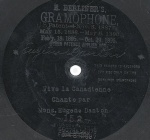 L’arbre est dans ses feuilles
Interpreter : Zachary Richard.
Writer : Zachary Richard.
Album : Travailler c’est trop dur / Anthologie 1976-1999, 1978.
L’arbre est dans ses feuilles
Interpreter : Zachary Richard.
Writer : Zachary Richard.
Album : Travailler c’est trop dur / Anthologie 1976-1999, 1978.
-
 Travailler c’est trop dur
Interpreter : Zachary Richard.
Writer : Zachary Richard.
Album : Travailler c’est trop dur / Anthologie 1976/1999, 1980.
Travailler c’est trop dur
Interpreter : Zachary Richard.
Writer : Zachary Richard.
Album : Travailler c’est trop dur / Anthologie 1976/1999, 1980.
Hyperliens
- Photographies des quartiers historiques de la Nouvelle-Orléans (freelargephotos.com)
- De la démocratie en Amérique (gallica.fr)
Catégories
Notes
English note (test)
Bibliographie
biblio test

